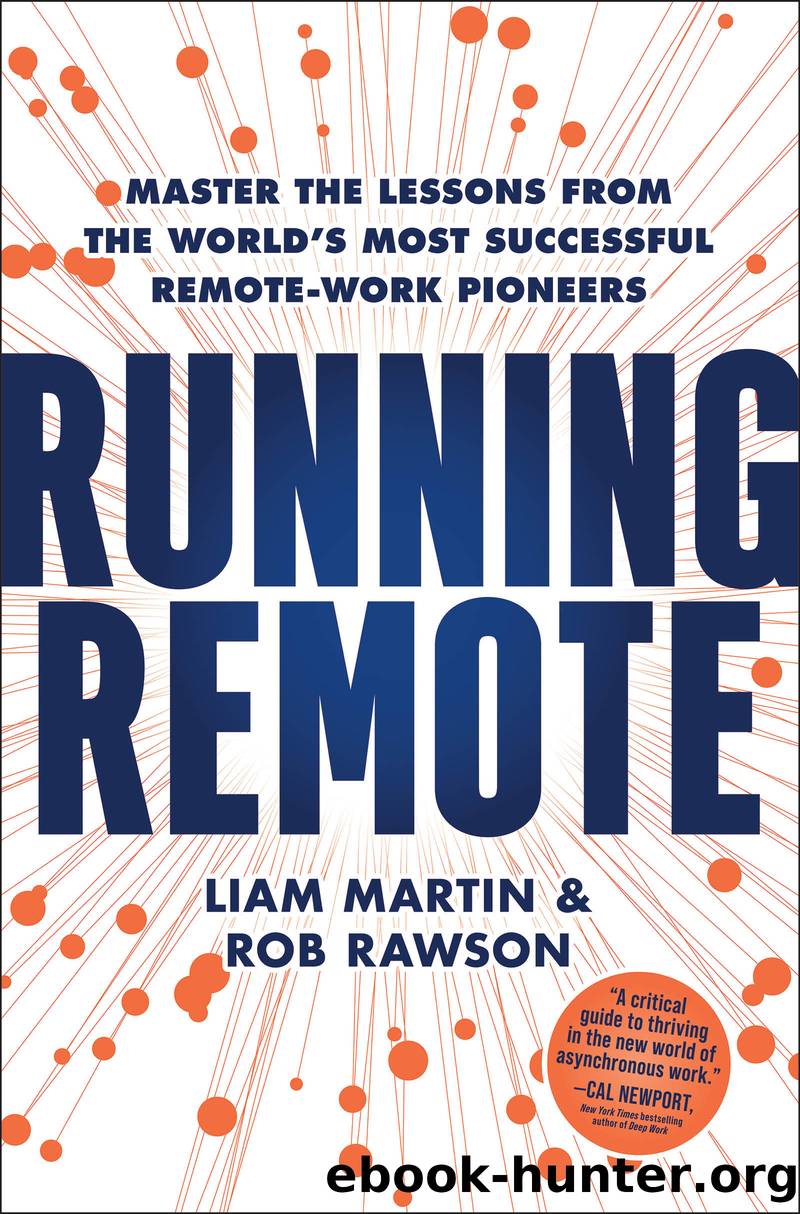Running Remote by Liam Martin

Author:Liam Martin
Language: eng
Format: epub
Publisher: Harpercollins Leadership
Published: 2022-05-25T00:00:00+00:00
REMOTE METRIC FUNDAMENTALS
Often, the greatest challenge in the art of metrics is not acquiring the numbers, but knowing how to use them to discover the true state of things. According to business.comâs Isaac Kohen, data is the âabundant resourceâ of our new age and âmany organizations are surrounded by oceans of information.â For smaller teams without the training and know-how, data analysis is an uphill battle.
Kohen prescribes five simple metrics that are as stable as the four major food groupsâyou canât survive without understanding them: 1) engagement, 2) productivity, 3) efficiency, 4) well-being, and 5) future-casting.
Engagement is not a matter of âmore is better.â Kohen describes it as a valuable metric that can âcut both ways.â Longer work hours paradoxically can correlate to lower productivity (and long-term burnout).
Productivity means tracking actionsâeverything from mouse activity to app engagement to email quantity and beyond. The key, as Kohen describes it, is making sure productivity impacts profitability.
Efficiency includes everything from process standardization to streamlining communication methodologies and scheduling best practices. According to Kohen, even behemoths like Microsoft âhave made transformative changes to their operations to maximize efficiency for a hybrid workforce,â optimizing its meeting schedule to avoid peak productivity hours.
Well-being is more than a clean bill of health. Sleep difficulties, substance abuse, chronic worry, and feelings of isolation can all be exacerbated by remote-first work when they arenât counterbalanced with healthy habits and human contact.
Finally, future-casting is the rock-bottom use of good metrics, so that âeveryday business owners can chart new goals for organizational structures, collaborative teams, and outcomes-focused hiring.â1
Kenjo2 blog smartly points out that SMART objectivesâthat is, objectives that are Specific, Measurable, Achievable, Relevant, and Timelyâmust always be âwell-defined and fulfill specific requirements.â To illustrate, they hunker down on a specific for each letter of the acronym:
Download
This site does not store any files on its server. We only index and link to content provided by other sites. Please contact the content providers to delete copyright contents if any and email us, we'll remove relevant links or contents immediately.
| Ethics | Etiquette |
| Fashion & Image | Health & Stress |
| Motivation & Self-Improvement | Work Life Balance |
| Workplace Culture |
Tools of Titans by Timothy Ferriss(8224)
Change Your Questions, Change Your Life by Marilee Adams(7638)
Deep Work by Cal Newport(6887)
Playing to Win_ How Strategy Really Works by A.G. Lafley & Roger L. Martin(5936)
Man-made Catastrophes and Risk Information Concealment by Dmitry Chernov & Didier Sornette(5926)
Digital Minimalism by Cal Newport;(5667)
Big Magic: Creative Living Beyond Fear by Elizabeth Gilbert(5616)
The Slight Edge by Jeff Olson(5353)
Ego Is the Enemy by Ryan Holiday(5297)
The Motivation Myth by Jeff Haden(5158)
Stone's Rules by Roger Stone(5027)
The Laws of Human Nature by Robert Greene(5003)
Tuesdays with Morrie by Mitch Albom(4696)
Eat That Frog! by Brian Tracy(4438)
Rising Strong by Brene Brown(4380)
Skin in the Game by Nassim Nicholas Taleb(4165)
Bullshit Jobs by David Graeber(4101)
The Money Culture by Michael Lewis(4083)
Skin in the Game: Hidden Asymmetries in Daily Life by Nassim Nicholas Taleb(3935)
